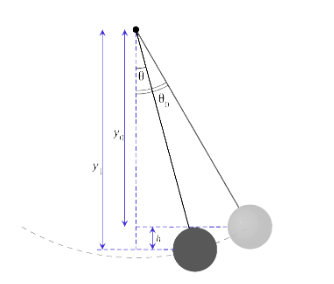
The frequency of a second’s pendulum is equal to:
1) 0.5Hz
2) 1Hz
3) 2Hz
4) 0.1Hz
Answer
477.6k+ views
Hint:A pendulum is a device which shows simple harmonic motion and is periodic in nature. It would oscillate from one extreme point to another until it comes to an equilibrium. A second’s pendulum is a pendulum in which the period is exactly two seconds. In one second, it will swing in one direction and in another second it will return.
Complete step by step calculation:
Here, the relation between the frequency and time period is:
Here:
For negligible mass on a weightless string of Length “L” which is swinging with an infinitesimally small amplitude and without any resistance, the length of the string would be

Final Answer:Option ”1” is correct. Therefore, the frequency of a second’s pendulum is equal to 0.5 Hz.
Note:The time period is defined as the time required to complete one cycle in an event which is repeating in nature whereas frequency is defined as the number of repeating events per unit of time. For example, if a child’s heart is beating 2 beats per 3 seconds then the frequency would be 0.9 and the time period would be 3 seconds. The time and frequency relation is reciprocal to one another. The seconds pendulum takes 2 seconds, so frequency would be 0.5 seconds.
Complete step by step calculation:
Here, the relation between the frequency and time period is:
Here:
F = Frequency;
T = Time Period;
For negligible mass on a weightless string of Length “L” which is swinging with an infinitesimally small amplitude and without any resistance, the length of the string would be

Now, we know that the second’s pendulum has a time period of 2 seconds so:
Final Answer:Option ”1” is correct. Therefore, the frequency of a second’s pendulum is equal to 0.5 Hz.
Note:The time period is defined as the time required to complete one cycle in an event which is repeating in nature whereas frequency is defined as the number of repeating events per unit of time. For example, if a child’s heart is beating 2 beats per 3 seconds then the frequency would be 0.9 and the time period would be 3 seconds. The time and frequency relation is reciprocal to one another. The seconds pendulum takes 2 seconds, so frequency would be 0.5 seconds.
Recently Updated Pages
Master Class 11 Economics: Engaging Questions & Answers for Success

Master Class 11 Business Studies: Engaging Questions & Answers for Success

Master Class 11 Accountancy: Engaging Questions & Answers for Success

Master Class 11 English: Engaging Questions & Answers for Success

Master Class 11 Computer Science: Engaging Questions & Answers for Success

Master Class 11 Maths: Engaging Questions & Answers for Success

Trending doubts
State and prove Bernoullis theorem class 11 physics CBSE

What are Quantum numbers Explain the quantum number class 11 chemistry CBSE

Write the differences between monocot plants and dicot class 11 biology CBSE

Why is steel more elastic than rubber class 11 physics CBSE

Explain why a There is no atmosphere on the moon b class 11 physics CBSE

1 ton equals to A 100 kg B 1000 kg C 10 kg D 10000 class 11 physics CBSE




